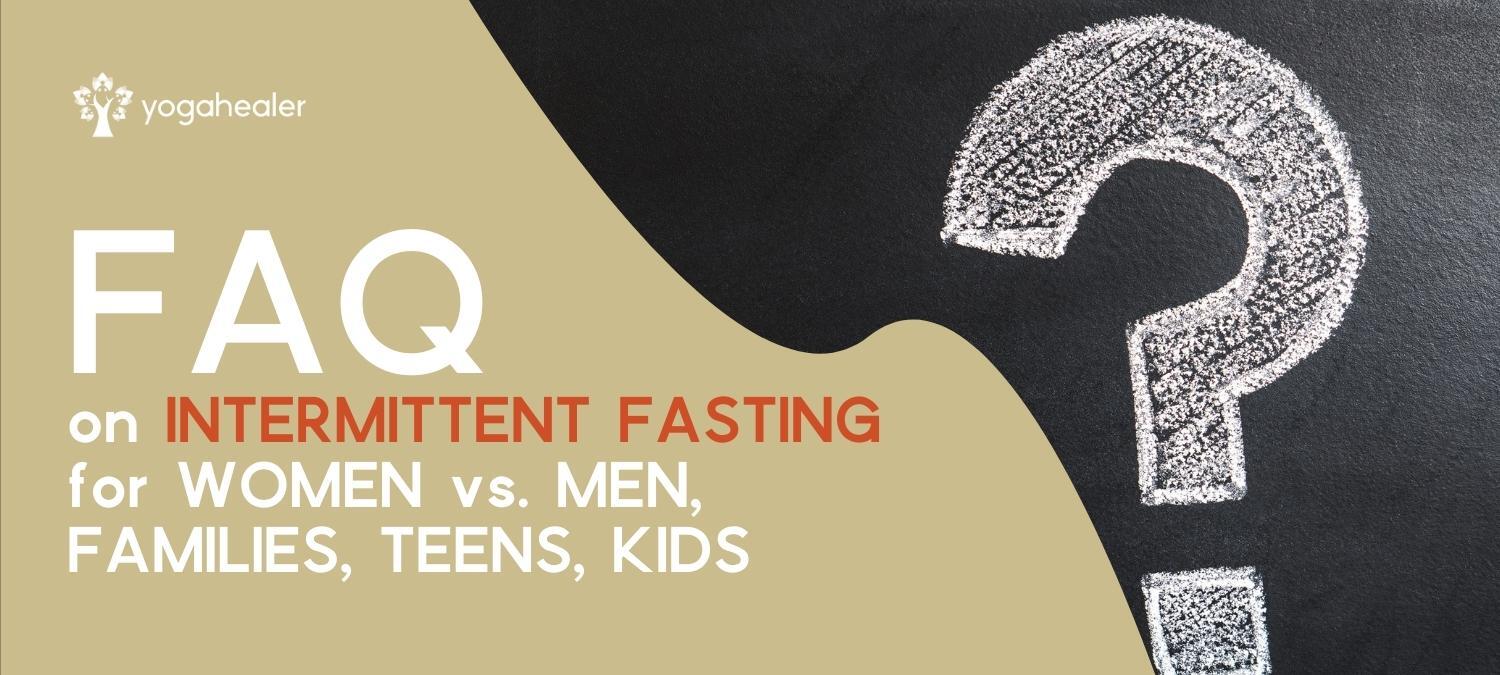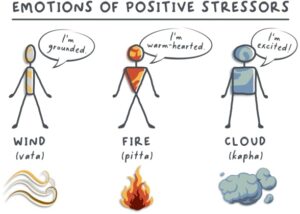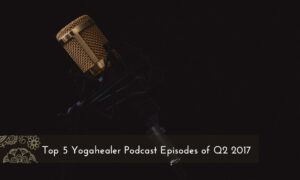What is intermittent fasting?
Intermittent fasting, what we’ll call fasting or IF for short, is eating in the rhythm that activates your cells to digest and rest. Fasting activates fat metabolism, which ignites cells to scavenge obsolete components.
Fasting is the anti-aging elixir you’ve been waiting for. Eating every few hours, overeating, eating too late, or eating when emotional disrupts cellular metabolism. As Dr. Jason Fung, a nephrologist and world-renowned expert on IF, says, “Fasting isn’t something you do. It’s something you don’t do.”
When you don’t eat as often, you have more time. IF is free, simple, convenient and flexible. IF prevents overthinking about food. IF is the when food component of a regenerative lifestyle. When you get the when right – what to eat becomes intuitive.
You’ll find your own way with fasting. Experiment one week at a time, and soon the practice becomes an automated habit that makes your life easier, your body trim, and your sleep deeper. In a week of rhythmic fasting, your cells rediscover the fuel in fat cells.
Why intermittent fast?
Fasting activates cells to scavenge for oxidative damage, damaged cells, inflammation, pathogens, dysbiosis, and cancer-promoting hormones, which then reduces all-cause mortality or dying from any disease.
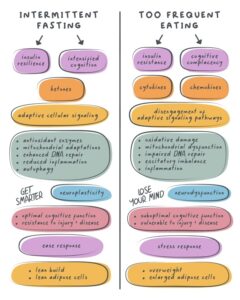
You become smarter and less prone to disease.
As your fat cells convert triglycerides into energy, your body becomes leaner and cleaner. To learn more about how your cells digest debris and detox, see AUTOPHAGY, FMD, and DETOX.
Eat too frequently and you disrupt this natural ability to regenerate cells, optimize your genetic expression and prevent disease. Hunger and satiation heal fat cells from producing inflammation to producing ant-oxidants (see ADIPOSE), just as fatigue and deep sleep reset the brain.
Your body digests itself into a higher order of efficient essentialism by not eating. You become more stable energetically and more organized at the cellular level, and able to learn. The intelligence of “feeling better” kicks in, making the habit of the fasting part of the daily fast/feed cycle a little easier.
Fasting between meals strengthens your digestive power, decreasing sensitivities, allergies to certain foods and building a hearty, intelligent appetite. When you pulse your fat cells, you desire nutrient-dense foods, including the highest quality fats you can get your hands on. Cravings for crap fall away. With rhythmic fasting, even the most pernicious neuroticism around food transmutes into a relaxed mind/body connection.
What is metabolic flexibility?
Your body is designed to use multiple fuel sources. The flexibility to switch between fuel from a recent meal or stored fat builds resilience.
Metabolic flexibility means that your body’s metabolism is flexible and can use whatever fuel is available to it, whether that’s fuel from food or fuel already stored in your body. If you’ve eaten a snack or a meal recently, your body will metabolize that food and use it for energy production. But if it’s been a while since you last ate, your metabolism can switch over to burning fuel that’s already in your body, like fat and sugar stores. Scientists refer to these fuel-burning processes as fat oxidation and glucose oxidation.
Is Intermittent Fasting bad for women?
Metabolic flexibility is reflected in what women need through the phases of their cycle. Many women find longer fasting times more difficult the week before they get their period.
The monthly grazing phase is designed to occur the week before a woman’s period. This progesterone phase of the monthly cycle should be nourished with more frequent 14/10s and fewer fasts lasting longer than 16 hours. If a woman aggressively fasts during the progesterone phase, the body freaks out like it’s starving, even if they’re overweight.
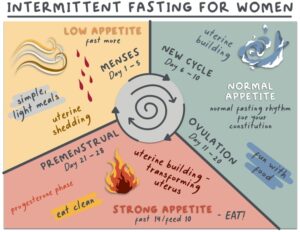
In the new cycle of uterine rebuilding, you have the most flexibility in your fasting and should play your edge, whether improved rhythm or autophagy.
Do men and women need to intermittent fast differently?
Mammals fast to thrive by design. We evolved through adversity. Men have more leeway than women, but both need metabolic flexibility.
Many men who go pro at the intermittent fasting habit find they prefer the low drama of the OMAD – the one meal a day. The increase in focus, the ease in their body, the attractive look of lean muscle, many men gravitate towards the deep daily autophagy of the OMAD, or later lighter lunch then dinner most of the time. A reminder to men: you also need metabolic flexibility, and during the month, you should mix in some 14/10s.
Is Intermittent Fasting bad for kids or teens?
Children are in the time of life dominated by the anabolic, spring season energy – the water phase of life. This fluid environment enables their cells to divide and the body to grow quickly. Snotty noses, carb cravings, picky eaters, and sugar addiction result from a feed cycle without a fast cycle. The more athletic your child, the higher quality fats and protein are needed at meals.
Snacks interrupt the digestion of real meals. Toddlers with a fast feed cycle have a shot at not developing chronic inflammation. If parents and teachers space their meals with time for digestion, children follow suit. If the parents and teachers snack, kids become snackers. If overeating is a habit at home, kids step on the train to chronic inflammation and weight issues, skyrocketing their propensity towards allergies and asthma.
Parents must find the fasting rhythm for their babies, toddlers, children, and teens. This rhythm has metabolic flexibility to balance social occasions with a stable home rhythm that optimizes autophagy.
The 13/11 is great for most toddlers. Kids with snot or pudge should push a 14/10. Depending on body type than age, WIND and FIRE kids can have a longer feed time (up to 11 hours) and more frequent meals, while CLOUD types thrive with a shorter feed time (8-10 hours) even two solid meals a day. Teach your kid their BODY TYPE.
Teens need to play with 16/8 and OMADS. Learn how to drive their vehicle, which requires fasting as much as fuel. If a teen struggles with mood or weight, guide them to find their next fasting rhythm.
Raise children to notice the effect of their choices and the cause that generates the effect. You’ll beget teens that design their next experience intelligently. Humans of all ages are a joy to be around when they allow the CIRCADIAN rhythm to set their fasting rhythm.
We are built for resilience and endurance. Your ancestors evolved with metabolic flexibility to pass their DNA onto you. Live in CIRCADIAN rhythm. Your lives together will evolve with meaning and the deep joy of family.
Is Intermittent Fasting bad for people with autoimmune disease?
To understand fasting and autoimmune disease you need to update your understanding of the function of adipose tissue (AT) and allostasis (opposite of homeostasis).
Adipose tissue (AT) is an immunological organ. AT cells include adipocytes, macrophages, and T cells, which reduce inflammation and repair genes for tissue homeostasis. Lean AT cells secrete anti-inflammatory hormones.
Stagnant AT cells are pro-inflammatory, generating and secreting abnormal levels of reactive oxygen species (ROS), nitrogen species (NOS), and hormones that dysregulate metabolism and immune function. This abnormal production shows the scales have tipped in the epigenome towards oxidative stress and away from antioxidant defense.
This leads to inflammation and insulin resistance2 to cancer-causing gene mutation5 and obesity (see NITRIC OXIDE). Stagnant AT cells produce autoimmune antibodies that lead to autoimmune disease.2 Intermittent fasting turns stagnant AT cells into lean AT cells.
For lean AT cells, food particles need to be digested, the cells need to change gears from digesting food to digesting waste.
How does chronic inflammation break down healthy tissue into diseased tissue?
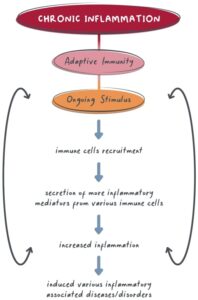
From Oxidative Medicine and Cellular Longevity1
With chronic allostasis, you can see that the immune system is recruited for clean-up. Yet, the immune system didn’t evolve with the chronic inflammation stressors of too much food or demolishment of the circadian rhythm.
We evolved with nutrition deprivation.
Chronic over-eating generates metaflammation, which disrupts metabolic cells.7
Chronic “otherness” interferes with “self.” Chronic inflammation is chronic allostasis. You are not standing at home in yourself. Notably, the lines between self and pathogen get blurry with chronic inflammation, which generates problems from frequent infections to autoimmune disease to cancer as the immune system breaks down.
Homeo means of the same kind, of the self.
Our immune system acts as a “double-edged sword” that can either heal or harm that is based on differentiating between the “self”’ and the “non‐self”’ and destroying only those tissues that are recognized as “non‐self.”6
Sanskrit uses a similar term to differentiate the sick from the healthy. Svastha is to be seated in the self. With primal habits, allostasis actually maintains homeostasis. With chronic, homeostasis isn’t possible.
Why not?
Autophagy is the cellular and intracellular digestive process that recycles molecules within cells through upcycling and downcycling. From cytoplasm to molecules to organelles, autophagy upgrades allostasis (other) into homeostasis (same) systemically.
“Other” metabolizes into self.
But, the kicker is…
Autophagy only happens when you pulse stored energy from the fat back into the blood.
Digestion within cells needs to be in tip-top shape for energy, functionality, and DNA regeneration. Autophagy is metabolic homeostasis at both the cellular and whole-animal level, preventing degenerative diseases regardless of organ or system. If you have chronic inflammation, you have autophagy issues. Without autophagy, the tissue becomes diseased, from Hashimotos to Diabetes to Crones10 (see INFLAMED, CHRONIC).

Autophagy reverses oxidative stress with the pruning of damaged mitochondria. Mitochondria are the energy factories within cells, the organelle that produces energy as ATP. Autophagy engulfs depolarized mitochondria with lysosomes. Hello fasting means goodbye damaged mitochondria, which means hello to more power for you.
The result?
Immune resilience.
Allostasis refers to the adaptive processes that maintain homeostasis through the production of mediators such as adrenalin, cortisol and other chemical messengers. These mediators of the stress response contribute to allostatic overload, the wear and tear on the body and brain that result from being “stressed out.”8
A chronic state of other – of not feeling at home in yourself – has become the norm.
Which means the body is always dealing with overproduction of inflammation mediators – adrenalin, cortisol, and other chemical messengers like cytokines and adipokines.
What goes undigested in cells becomes toxic waste that disrupts the endocrine system – which is in charge of mediating all chemical signals in the body. This inflammatory waste slowly destroys the natural intelligence in human design.
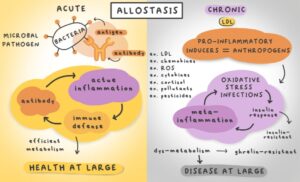
Q. Is it better to fast in the morning or evening?
In a 16/8, your fast time is 16 hours. Your “feed time” is 8 hours. This is the baseline daily fasting rhythm.
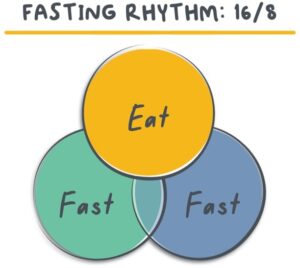
Morning fasters eat between noon and 8 pm on a normal day. Evening fasters eat between 8 am and 4 pm. Many people find it’s better for digestion to eat midday than later in the evening.
Having a core rhythm and mixing it up develops metabolic flexibility. Signs of metabolic flexibility are that you can easily balance your weight, have great energy, sleep well, and enjoy working out, even hard workouts.
Mixing it up looks like a feed/fast rhythm that may include fasting between 14 hours and 16 hours, 20-24 hours in a weekly rhythm. Eventually, it becomes normal to have one main meal a day, and on some days, a smaller meal and a larger meal.
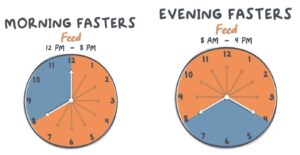
How should I fast for my Body Type?
Look at the three types. See which one you are, or a combo of. Then follow those recommendations:
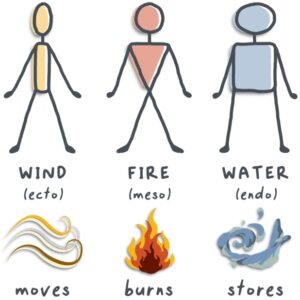
WIND types are fast, fun, and, as the wind, like to fly. The symbol of the ectomorph catabolic type is the elongated rectangle. People with this constitution usually have thin, lithe muscles, are naturally lighter for their size, and often have fluctuating digestion. They often unintentionally skip meals and prefer spontaneity over regularity.
Fire types are fiery, sharp, and like intensity, goals, and progress. The symbol of the mesomorphic metabolic type is the inverted triangle. Fire types metabolize energy quickly and have strong hunger and fast digestion. Sometimes too spicy makes digestion too fast. Too oily makes the passage slick.
WATER types are calm, patient, caring, and gravitate towards consistency and comfort. The symbol of the endomorphic anabolic type is the stable square. People with this constitution usually have dense, sturdy bodies. Their habits can be exceedingly regular and routine. The slow burner needs less food than the other types yet has a generous body to store used calories. This type requires the most extended fasts as it’s exceedingly easy for them to overeat or eat too frequently.
WIND FASTING RHYTHM Alternate 14/10 and 16/8 with occasional 18/6 or 20/4 Break Fast between 8–10 am Dinner: 1-5 pm
FIRE FASTING RHYTHM Alternate 16/8 days with 18/6 and 14/10 days Brunch: 10 am - noon Dinner: 4-6 pm
WATER FASTING RHYTHM Alternate 18/6 and 20/4, OMADS Morning: black coffee or butter coffee if you have cravings One meal: 12-6 pm Optional small meal: soup, salad, popcorn
How do you fast when you have to feed a family?
A simple organizing structure for families with the most basic habits around food and rest is to have a super dorky, super-effective 10-minute family meeting once a week.
Give everyone a minute or two to answer these questions:
- What do you have coming up this week?
- How do you want to feel this week?
- What is your eating window/fasting schedule to feel that way?
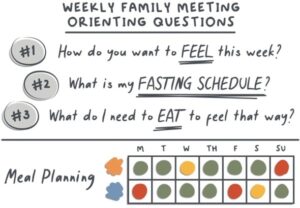
- What do you need to eat to feel that way?
See if you can pull together some common meal ideas and a schedule for the week. Organize and schedule the shopping, cooking, and distribute the load. You’ll get better with practice.
Aim for a solid B, so it’s about reorienting to the target rather than perfection. Give everyone leeway to find their rhythm.
Q: What happens if you don’t intermittent fast?
Chronic inflammation morphs tissue into chronic disease. Daily habits generate cellular inflammation. Inflammation accumulates beyond a threshold dysregulating the local tissue, spreading into the organ or specific system of the body. Dysfunction follows. Eventually, a specific disease can be diagnosed.
Chronic is a modern phenomenon. In 1935, 7.5% of American adults were chronic. Today we’re at 60% with a solid trajectory towards more suffering.9 Over 85% of health care costs go to treat chronic diseases.4
Allostatic load scores reflect the state of disease at large within you. Biomarkers in the cardiovascular, metabolic, and inflammatory systems predict how sick your body is by how many systems and microbiomes are dysregulated, and how much aging is accelerated.11 The cumulative burden from the current chronic stressors, or load, is a combo of data across these physiological systems.
The worse you feel, in yourself or about yourself, the higher your allostatic load.
With load, resources go to inflammation to mark and clean up “otherness.” The cost is chronically attacking self-generated inflammation, rather than optimizing health. It’s not the same.
The pathway looks like this:
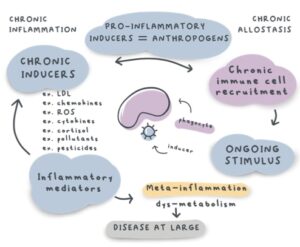
Fasting between meals strengthens your digestive power, decreasing sensitivities, allergies to certain foods and building a hearty, intelligent appetite. When you pulse your fat cells, you desire nutrient-dense foods, including the highest quality fats you can get your hands on. Cravings for crap fall away. With rhythmic fasting, even the most pernicious neuroticism around food transmutes into a relaxed mind/body connection.
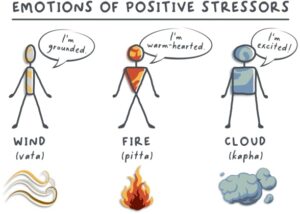
Fat cells stimulated into releasing triglycerides is a mellow, stable affair. The mind becomes more relaxed the more hours and days spent fasting (see DETOX, FMD, CHANNELS). Your nervous system relaxes into rest and digest mode. Brain function and cognition improve, brainwave states become more flexible, the mind focuses. Fasting as a habit digests mental confusion into specific desires of a vision for a brighter life.
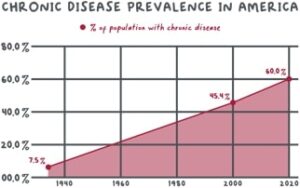
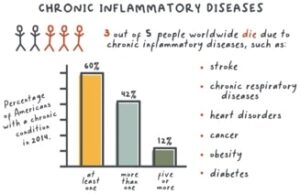
Q: What is a five-day FMD? (Fast Mimicking Diet)
The Fast Mimicking Diet is the newest term for a time-tested custom of significantly reducing calories for periods.
Since a 1935 study with rats, scientists have known that calorie restriction extends life span and prevents chronic disease. The rats increased maximal lifespan by up to 50% while improving general health and decreasing aging-associated diseases.3
Calorie restriction means that you are eating less than 70% of what you normally would, for example, 500-800 calories instead of 2000-2500. Humans, like all mammals, respond to calorie restriction with improved physiological and cognitive performance, longer lifespans, cell regeneration, decreased inflammation, and fat loss.
An Italian biologist and researcher, Dr. Valter Longo, created an easier way to receive the benefits of fasting through calorie restriction; 70% fewer calories (500-750 calories per day) for five days. He popularized the concept by creating a product, Prolon, that was based on his nutritional research using mini-meals for five days with the following breakdown of macronutrients:
- Day 1: 1,090 cal (10% protein, 56% fat, 34% carbs)
- Days 2-5: 500-725 cal (9% protein, 44% fat, 47% carbs)
Benefits of the FAST MIMICKING DIET (FMD) include:
- Autophagy and apoptotic cellular clearing/repair
- Decrease oxidative stress and inflammation
- Increase mental performance and BDNF (brain stem cells that create new neurons)
- Removal of cancerous or precancerous cells – Increase immune system functioning
- Increase lean tissue mass
- Decrease in fat tissue
- Rapid shifting into nutritional ketosis
- Increase gene expression for long periods
At Yogahealer, we run a PRIMAL HABITS Challenge twice a year for a few weeks and include a five-day homestyle FMD. Many members at Yogahealer already cooked whole foods from scratch and had the calories they needed for FMD in the fridge and cupboard.
Foods that work well with FMD:
- Fermented foods
- Fresh organic vegetables, especially celery
- Marinated olives, beans, or vegetables
- Soaked or sprouted nuts
Celery is the bomb if you want to chew, averaging ten calories a stick. Celery also provides fiber, and when you give that to your intestinal microbiome, it has a ladder to grow up. Mix some miso soup, sauerkraut, or kimchi into your diet during FMD and have a microbiome rebuilder. Add into the day a small nut bar or hard-boiled egg, butter chai, or coffee, along with some olives, and you’re about at 500 calories. It’s that simple.
You can now take time off cooking for five days and FOCUS on other priorities.
Beginners do well with menus where they calculate meals and portions ahead of time. With experience, our members find they intuitively know how much of what they want next within the parameters. Not having rehydrated, dehydrated soup packets, probiotic sauerkraut, and miso soup made all the difference.
Citations:
1 Image from Arulselvan, Palanisamy, et al. “Role of Antioxidants and Natural Products in Inflammation.” Oxidative Medicine and Cellular Longevity, vol. 2016, 2016, p. 5276130. doi:10.1155/2016/5276130. Egger, Garry. “In Search of a Germ Theory Equivalent for Chronic Disease.” Preventing Chronic Disease, vol. 9, 2012, E95. doi:10.5888/pcd9.110301.
Egger G. In Search of a Germ Theory Equivalent for Chronic Disease. Prev Chronic Dis 2012;9:110301. DOI: http://dx.doi.org/10.5888/pcd9. 110301.
2 Frasca, Daniela, and Bonnie B. Blomberg. “Adipose Tissue: A Tertiary Lymphoid Organ: Does It Change with Age?” Gerontology, vol. 66, no. 2, 2020, pp. 114–21. doi:10.1159/000502036.
3 Fontana, Luigi, et al. “Extending Healthy Life Span–from Yeast to Humans.” Science, vol. 328, no. 5976, 2010, pp. 321–26. doi:10.1126/science.1172539.
4 Holman, Halsted R. “The Relation of the Chronic Disease Epidemic to the Health Care Crisis.” ACR Open Rheumatology, vol. 2, no. 3, 2020, pp. 167–73. doi:10.1002/acr2.11114.
5 Landskron, Glauben, et al. “Chronic Inflammation and Cytokines in the Tumor Microenvironment.” Journal of Immunology Research, vol. 2014, 2014, p. 149185. doi:10.1155/2014/149185.
6 Liu, Chao, et al. “Cytokines: From Clinical Significance to Quantification.” Advanced Science, vol. 8, no. 15, 2021, e2004433. doi:10.1002/advs.202004433.
7 Li, Chuan, et al. “Macrophage Polarization and Meta-Inflammation.” Translational Research, vol. 191, 2018, pp. 29–44. doi:10.1016/j.trsl.2017.10.004.
8 McEwen, Bruce S. “Stressed or Stressed Out: What Is the Difference?” Journal of Psychiatry and Neuroscience, vol. 30, no. 5, 2005, pp. 315–18.
9 Nobbs, J. “What’s Driving Chronic.Disease?” Jeffnobbs.com. 1 Jan. 2020, www.jeffnobbs.com/posts/whatcauses-chronic-disease. Accessed 20 Apr. 2022.
10 Rabinowitz, Joshua D., and Eileen White. “Autophagy and Metabolism.” Science, vol. 330, no. 6009, 2010, pp. 1344–48. doi:10.1126/science.1193497.
11 Robertson, Tony, et al. “The Role of Material, Psychosocial and Behavioral Factors in Mediating the Association Between Socioeconomic Position and Allostatic Load (Measured by Cardiovascular, Metabolic and Inflammatory Markers).” Brain, Behavior, and Immunity, vol. 45, 2015, pp. 41–49. doi:10.1016/j.bbi.2014.10.005.

